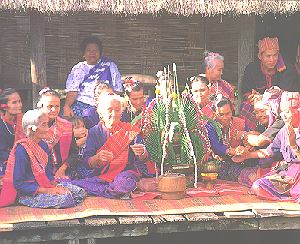 Bai-See Su-kwan is a ceremony of blessings practised among the Phu Tai people of Sakol Nakhon Province
in northeastern Thailand. Believrd to have migrated across the Mekong River from Dien Bien Fu, The Phu Tai share the same ethnic roots with the Tai Dam.
Bai-See Su-kwan is a ceremony of blessings practised among the Phu Tai people of Sakol Nakhon Province
in northeastern Thailand. Believrd to have migrated across the Mekong River from Dien Bien Fu, The Phu Tai share the same ethnic roots with the Tai Dam.
- Unlike the Thais, who are known as the people of Thailand, the Tais or Dais are known under different names in the various localities where they are found.
- The Anthropology Center of Australia estimates that about 90 million people of the Tai race are scattered around the Mekong Basin. These people have several things in common, including the language root.
- This observation collaborates a report written by Dr. William Clifton Dodd, an American missionary, in his memoir titled "The Tai Race: The Elder Brother of the Chinese." Dr. Dodd worked in northern Thailand in the reign of Rama V.
- According to his memoir, Dr. Dodd had no problem communicationg with the Tai people in the different communities he visited, relying only on the dialect of northern Thailand which people he spoke very well. However, his assertion that the Tai race is older than the Chinese or Hebrews is vigorously challenged by anthropologists.
- Neverthess, Dr. Dodd observes that wherever they are, the Tai race people share a distinctively similar culture and agricultural inclination, i.e., they are highly devout Buddhists and rice growers. Before there social order was disrupted by major political changes five or six decades ago, they lived in communities under a monarchic role.
|
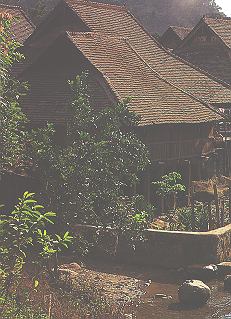 The Tai Lue village of Van in Xixhuanpanna epitomizes ancient settlements on river banks.
The Tai Lue village of Van in Xixhuanpanna epitomizes ancient settlements on river banks.
- Through his study, Louis Finot, former director of the Far East Study Center in Paris, seems to have formed an understanding of the Tai mystery.
- 'The migration of the Tai was as quiet as the flow of the brook which took a deep, penetrating root, changing with the changing color of the sky and form of the contour of the land.
But their unique identity of a nation and language remains intact. The expansion of the Tai race thus resembles a huge piece of fabric spreading over Southern China, Tung Kia, Laos, Siam, and Myanmar...'
- But does Finot's account refer to the same migration recorded in Thai history books, that is, that the Tais migrated from the Altai Mountains through the Kobe Desert to Taleephu, where they founded the Nanchao Empire, before they again fled Chinese aggression down to the Mekong Basin?
|
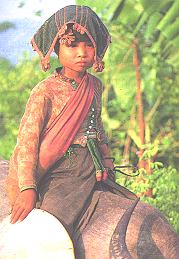
Wearing the delicately woven 'piew' is unique among Tai Dam women
|
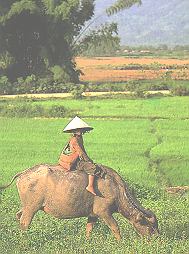
Wearing Vietnameese hats from whom they adopted the practice of wearing hats.
| The recent liberalization of the knowledge frontier has brought about more hypotheses on the origin of the Thai people themselves. The most credible account, however, by Professor Prasert Na Nakhon,
a member of the Thai Royal Institute, who wrote that the migration root of the Thai people stretched from the southernmost part of China in Kwangxi to Dien Bien Fu's Lai Chao in Vietnam's northernmost region.
This region was once the center of Xixongchutai, or Xixongchutai Empire, the ancient empire of the Tai ethnic race which was regarded as an economic and military power. The Tais spoke many dialects, which, although sharing the same roots, were so diverse that the words were simply not the same.
|
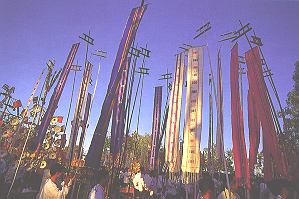 The making of 'Trung' or banners used in merit-making processions is another tradition among the Tai people.
Used for worshipping, the different layers of the 'Trung' are likened to a staircase that lead their makers to heaven when they die.
The making of 'Trung' or banners used in merit-making processions is another tradition among the Tai people.
Used for worshipping, the different layers of the 'Trung' are likened to a staircase that lead their makers to heaven when they die.
- Although and absolute conclusion about the origin of the Tai race is yet to be found, scholars of art and culture agree that the Tais share the same habits and culture.
Settling on the river banks, they are good farmers who eat sticky rice and fish as their staple food, live in houses on stilts with open space underneath, beat drums, and dress in sarongs and turbans.
- Spirits are a common phenomenon in the Thai culture; a city, for instance, has a guardin spirit. Likewise, their close association with water and ricefields is reflected in the saying, "While eating rice, don't forget the ricefield spirit. And never forget the water spirit which gives fish.'
This ancient wisdom teaches the future generations that the droughts and floods that they experience are the consequences of their own failure to coexist in harmony with nature.
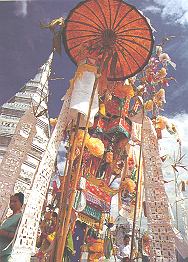 Tradition of decorating merit-making items reflect the deep devotion of the Tai Lue to Buddhism.
Tradition of decorating merit-making items reflect the deep devotion of the Tai Lue to Buddhism.
|
|
Siam is the name by which the country was known to the world until
1939 and again between 1945 and 1949. On May 11, 1949, an official proclamation changed the name of
the country to "Prathet Thai", or "Thailand", by which it has since been known. The word
"Thai" means "free", and therefore "Thailand" means "Land of the Free."
|
Top
|
|
Return to the main page
|





